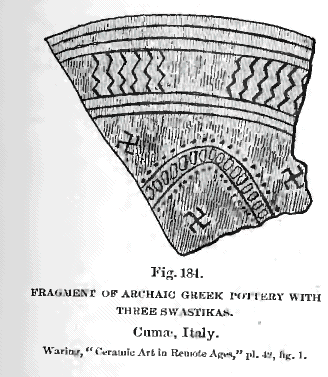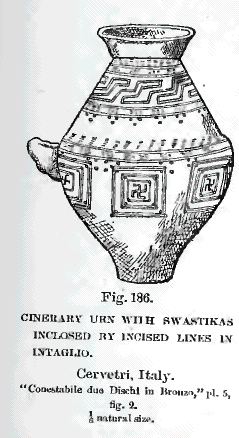

The Swastika
Dispersion of the Swastika
 Phenician.
When we consider the rarity of Phenician pottery in Italy compared with
the great amount of Greek pottery found there, and that the Phenicians
are not known to have employed the Swastika, this, combined with the difficulty
of determining the place of origin of such a fragment, renders it more
likely to have been Greek than Phenician. A reason apparently moving Rochette
to this decision was the zigzag ornamentation, which he translated to
be a Phenician sign of water; but this pattern was used many times and
in many places without having any such meaning, and is no proof of his
proposition.
Phenician.
When we consider the rarity of Phenician pottery in Italy compared with
the great amount of Greek pottery found there, and that the Phenicians
are not known to have employed the Swastika, this, combined with the difficulty
of determining the place of origin of such a fragment, renders it more
likely to have been Greek than Phenician. A reason apparently moving Rochette
to this decision was the zigzag ornamentation, which he translated to
be a Phenician sign of water; but this pattern was used many times and
in many places without having any such meaning, and is no proof of his
proposition.Figs. 185 and 186 represent the one-handled cinerary urns peculiar to the Bronze Age in Italy. They are believed to have been contemporaneous with or immediately succeeding the hut urns just shown. The cinerary urn shown in fig. 185 was found at Marino, near Albano, in the same
 locality
and under the same condition as the hut urns. The original is in the Vatican
Museum and was figured by Pigorini in "Arcæologia,: 1869. Fig.
186 shows a one-handled urn of pottery with Swastika (left) in intaglio,
placed in a band of incised squares around the body of the vessel below
the shoulder. A small though good example of Etruscan work is shown in
the gold fibula (fig. 187).
It is ornamented on the outside with the fine gold filigree work peculiar
to the best Etruscan art. On the inside are two Swastikas. It is in the
Vatican Museum of Etruscan antiquities. Fig.
188 represents another specimen of Etruscan gold filigree work with
a circle and Swastika. It is a "bulla," an ornament said to
indicate the rank of the wearer among the Etruscan people. It is decorated
with a circle and Swastika inside. The figure is taken form "L'Art
pour Tous," and is reproduced by Waring.
locality
and under the same condition as the hut urns. The original is in the Vatican
Museum and was figured by Pigorini in "Arcæologia,: 1869. Fig.
186 shows a one-handled urn of pottery with Swastika (left) in intaglio,
placed in a band of incised squares around the body of the vessel below
the shoulder. A small though good example of Etruscan work is shown in
the gold fibula (fig. 187).
It is ornamented on the outside with the fine gold filigree work peculiar
to the best Etruscan art. On the inside are two Swastikas. It is in the
Vatican Museum of Etruscan antiquities. Fig.
188 represents another specimen of Etruscan gold filigree work with
a circle and Swastika. It is a "bulla," an ornament said to
indicate the rank of the wearer among the Etruscan people. It is decorated
with a circle and Swastika inside. The figure is taken form "L'Art
pour Tous," and is reproduced by Waring.An ornamental Swastika (fig. 189) is found on a silver bowl from Cervetri (Cære), Etruria. It is furnished by Grifi, and reproduced by Waring. This specimen is to be remarked as having a small outward flourish from the extreme end of each arm, somewhat similar to that made by the Jains (fig. 33), or on the "Tablet of honor" of Chinese porcelain (fig. 31). Fig. 190 shows an Etruscan bronze fibula with
 two Swastikas and two Maltese crosses in the pin shield. It is in the
Museum of Copenhagen, and is taken from the report of the Congrés
Internationale d'Anthropologie et d'Archæologie Préhistorique,
Copenhagen, 1875, page 486. This specimen, by its rays or crotchets around
the junction of the pin with the shield, furnishes the basis of the argument
by Goblet d'Alviella (1) that
the Swastika was evolved from the circle and was a symbol of the sun or
sun-god. (See p. 785.)
two Swastikas and two Maltese crosses in the pin shield. It is in the
Museum of Copenhagen, and is taken from the report of the Congrés
Internationale d'Anthropologie et d'Archæologie Préhistorique,
Copenhagen, 1875, page 486. This specimen, by its rays or crotchets around
the junction of the pin with the shield, furnishes the basis of the argument
by Goblet d'Alviella (1) that
the Swastika was evolved from the circle and was a symbol of the sun or
sun-god. (See p. 785.)Bologna was the site of the roman city Bononia, and is supposed to have been that of Etruscan Felsina. It's Etruscan cemetery is extensive. Different names have been given to the excavations, sometimes from the owner of the land and at other times from the names of excavators. The first cemetery opened was called Villanova. The culture was different from that of the other parts of Etruria. By some it is believed to be older, by others younger, than the rest of Etruria. The Swastika is found throughout the entire
ENDNOTES:
1. "La Migration des Symboles," p. 67. [Back]
<< Previous Page Next Page >>
© 2004-2007 Northvegr.
Most of the material on this site is in the public domain. However, many people have worked very hard to bring these texts to you so if you do use the work, we would appreciate it if you could give credit to both the Northvegr site and to the individuals who worked to bring you these texts. A small number of texts are copyrighted and cannot be used without the author's permission. Any text that is copyrighted will have a clear notation of such on the main index page for that text. Inquiries can be sent to info@northvegr.org. Northvegr™ and the Northvegr symbol are trademarks and service marks of the Northvegr Foundation.

|